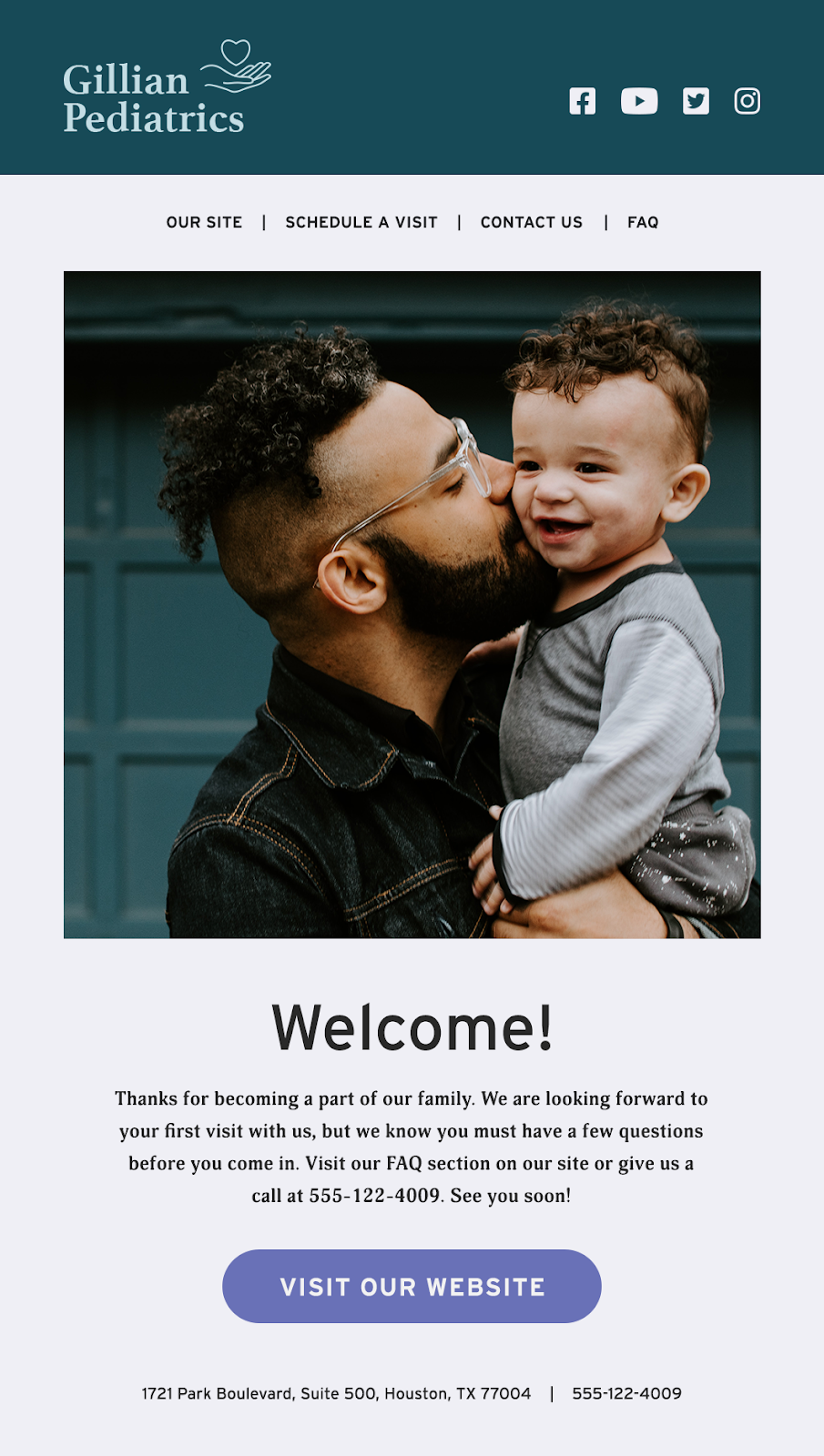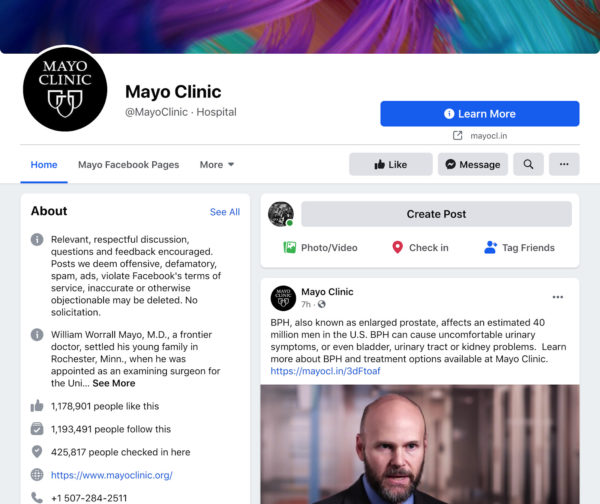
As a marketing leader of a multi-site or multi-department healthcare organization, you are aware that brand positioning can determine which health systems or providers patients choose — and which services they pursue.
Effective healthcare marketing will empower prospective patients while forming stronger relationships between patients and healthcare providers. Consider integrating these top options into your healthcare marketing strategy:
- 1. Email marketing
- 2. Referral programs
- 3. Digital resources to boost search engine optimization (SEO)
- 4. Online reviews and reputation management
- 5. Social media
- 6. Pay-per-click advertising
- 7. Google Business Profile
- 8. Be an authority in the healthcare space
- 9. Brand consistency and time-saving tools for multiple accounts

Email marketing for multi-site
and multi-department healthcare organizations
Manage brand consistency, content, and contact lists — across departments and locations. Save time and access all accounts from a centralized dashboard. Bulk pricing for multiple accounts
1. Email marketing
An essential element of any healthcare marketing campaign, email marketing provides powerful and consistent connections with patients, vendors, and many other important individuals. Regular updates offer insight into recent developments that email recipients might find interesting, while also highlighting your organization’s status as an industry authority. This facilitates name recognition, which can be powerful when patients need to make prompt decisions about healthcare providers.

The most effective healthcare email marketing initiatives involve mobile-friendly content, engaging headlines, and patient-oriented messages that provide real value to recipients. Overly “sales-y” language should be avoided.
Deliver useful information with a call-to-action, and conversions will naturally follow.
2. Referral programs
Marketing campaigns across many industries draw on the power of word of mouth, but this classic tactic is particularly effective for attracting new patients. A strong sense of trust is essential — and it’s often most easily established by discussing options with friends, family members, or healthcare professionals. This is the power of a strong referral program, in which word of mouth takes on a more purposeful approach.
While often effective, patient referral programs involve some element of risk, as local regulations or supervisory boards may restrict incentive-based marketing. If implemented within the scope of this guidance, however, referrals could deliver qualified leads with help from incentives such as discounts for new patients.
3. Digital resources to boost search engine optimization (SEO)
Worried patients often dedicate considerable time to searching for symptoms online before they finally choose to visit the doctor. While browsing search engine results pages (SERPs), many seek content from trusted healthcare providers.
Ideally, digital resources will be tailored to meet the unique needs of targeted patients. To ensure personalized content, determine the types of searches patients are most likely to conduct online. From there, provide engaging healthcare content that includes natural-sounding keywords to help them find much-needed information.
Simple tools can be especially effective for driving traffic. Examples could include body mass index (BMI) calculators, calorie counters, or medication dosage charts. These tools provide obvious value for prospective patients while also verifying your status as a trustworthy organization that prioritizes patients’ needs.
4. Online reviews and reputation management
Today’s consumers seek ample social proof before making virtually any purchase imaginable. Data from the Pew Research Center reveals that 82 percent of adults read online ratings at least occasionally before purchasing products for the first time. What’s more, many tell Pew that they consider online reviews more useful than government regulations, especially in regard to how confident they feel about their purchases.
While these statistics largely apply to retail purchases, the same concept holds true in healthcare, with patients increasingly looking to ratings for insight into facilities, doctors, and specialists. In a noteworthy survey conducted by One Poll, a whopping 95 percent of respondents claimed to find online healthcare reviews at least somewhat reliable. What’s more, 41 percent of those who received referrals directly from healthcare professionals still chose to look at reviews online.
The takeaway? A lack of reviews could cause huge problems for your healthcare organization, as patients are often skeptical of professionals or facilities that lack ratings.
Of course, reviews can open the door to negative feedback — hence the need for a strong reputation-management solution, which allows you to enjoy greater control over your online impression.
5. Social media
Beyond reviews and simple word of mouth, social media for healthcare offers one of the best opportunities for building trust with prospective patients. Your organization’s Facebook business page, in particular, provides a close look at your philosophy and general approach to care.

On Facebook, followers can join a virtual community of patients while receiving regular updates. They can comment on or share posts to increase awareness of your service — or provide reviews directly on your Facebook business page to let potential patients know about their experience within your facilities.
The Facebook business page provides a powerful starting point for your social media campaign, but your reach will extend that much further if you implement Facebook Ads. This paid option involves a wide variety of self-serve tools, as well as easy-to-navigate reports for tracking key performance indicators.
With over 1.6 billion users connected to small businesses via Facebook, the social media giant remains a wonderful option for small to midsize facilities or networks that might otherwise struggle to gain much-needed social media exposure.
Facebook may be a go-to resource for prospective patients, but it’s by no means the only social media option available. From private practices to major networks, an increasing share of organizations regard Instagram as a top option for connecting with followers. If you go this route, take advantage of Constant Contact’s social media tools.
LinkedIn is also popular among many types of healthcare professionals, ranging from doctors and nurses to pharmacists and even hospital executives. The platform claims that LinkedIn Matched Audiences makes it possible to increase reach by 25 percent. Additionally, LinkedIn’s Sentiment Analysis can be called upon for insight into consumer opinions. This, in turn, can be used to tweak social media efforts as needed to deliver stronger brand positioning.
6. Pay-per-click advertising
While many healthcare organizations primarily opt for an organic strategy built around strong SEO, there’s something to be said for the short-term gains that pay-per-click advertising (PPC) can provide. It takes time to build a well-rounded email list or social media presence, but PPC can improve brand awareness in short order.
Healthcare is a huge area of concern among search engine users, with data from Google revealing that one in 20 of the site’s searches involves a health-related query. While PPC presents unique challenges such as restrictions related to HIPAA and remarketing, the exposure provided via paid strategies can make all the difference for organizations struggling to break through in a competitive online environment.
7. Google Business Profile
When seeking insight into potential healthcare providers, many patients first look to Google. Google Business Profile allows business owners and marketers to edit the listings that patients find through search, including details such as business hours, contact information, and even telehealth services.
With Google as a starting point, both new and current patients can book online appointments or find directions to a particular facility. This serves as an effective call to action, driving quick conversions among patients eager to move forward in their healthcare journey.
8. Be an authority in the healthcare space
No matter which online platforms you use, or how, it’s imperative that you position your organization as a healthcare authority. If patients don’t perceive you this way, they may not be confident enough to entrust your organization with their most prized possessions: their health and safety.
To get started with developing and implementing a comprehensive healthcare marketing strategy, check out The Download for health professionals.
9. Brand consistency and time-saving tools for multiple accounts
Constant Contact has specific features built just for multi-site and multi-department healthcare organizations. With us, all the tools you need for email marketing campaigns are in one place. Contact us to learn more!
- Ensure brand consistency with locked branded templates
- Manage content and contact lists — across departments and office locations
- Save time by accessing multiple accounts from a centralized account dashboard
- Utilize segmentation tools to reach the right contacts with the right messaging at the right time
- Track results with real-time reporting tools to see who’s engaging with your campaigns
- Automate email marketing with personalized, scheduled, and targeted emails
- Take advantage of bulk pricing for multiple accounts

Email marketing for multi-site
and multi-department healthcare organizations
Manage brand consistency, content, and contact lists — across departments and locations. Save time and access all accounts from a centralized dashboard. Bulk pricing for multiple accounts




